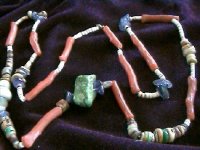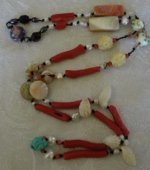J
You are using an out of date browser. It may not display this or other websites correctly.
You should upgrade or use an alternative browser.
You should upgrade or use an alternative browser.
P
pattye
Guest
Hi Joan,
The seller has been around awhile, but I don't see anything about a return policy. Have you asked any questions? And gotten replies?
Pattye
The seller has been around awhile, but I don't see anything about a return policy. Have you asked any questions? And gotten replies?
Pattye
P
perlas
Guest
Hi Joan,
Angel Skin Coral is harvested in the Philippines and Taiwan. However, there are restrictions due to illegal and excessive harvesting of corals.
Coral beads are a tad more expensive than other gemstone beads.
Dyed ones are cheaper than natural-coloured ones. The most expensive is the natural red coral, then the angel skin.
Angel Skin Coral is harvested in the Philippines and Taiwan. However, there are restrictions due to illegal and excessive harvesting of corals.
Coral beads are a tad more expensive than other gemstone beads.
Dyed ones are cheaper than natural-coloured ones. The most expensive is the natural red coral, then the angel skin.
J
Joan A
Guest
Thanks for the comments, they look fun, but too expensive.
V
Valeria101
Guest
Yeah... sort of pricey. While high carat gold is cute, this one looks like something I could put together myself... using some old beads. Unfortunately for the coral, the smaller beads are sold for allot less and treatment is hard to catch even in person (on some) let alone through a picture. To be honest, I am not sure what would be a threshold size after which coral beads are 'large'. The absolute 'monster' on my record are about 20mm... bordering the unwearable, IMO, and the biologically impossible, as far as I know.
Speaking of which: how about these guys? The orange color and strong graduation would explain the price to me, even w/o color enhancement. And the settings on the earrings are quite lovely. Some natural pearls next to them for good measure too.
I really don't have allot of coral, some cuff links... and a handful of branch beads I've never got to restring after a mishap years back.
Speaking of which: how about these guys? The orange color and strong graduation would explain the price to me, even w/o color enhancement. And the settings on the earrings are quite lovely. Some natural pearls next to them for good measure too.
I really don't have allot of coral, some cuff links... and a handful of branch beads I've never got to restring after a mishap years back.
Last edited by a moderator:
P
perlas
Guest
Hi Valeria,
the one you posted looks like "bamboo corals", at least what's that they call it here, having the brick red color. You can see the pores in bamboo corals. They usually come from Thailand (or at least thru Thailand).
20mm bead strands are possible but not very often. Even coral "wands" are sold in my area, coming from Mindanao.
the one you posted looks like "bamboo corals", at least what's that they call it here, having the brick red color. You can see the pores in bamboo corals. They usually come from Thailand (or at least thru Thailand).
20mm bead strands are possible but not very often. Even coral "wands" are sold in my area, coming from Mindanao.
V
Valeria101
Guest
perlas said:Hi Valeria,
the one you posted looks like "bamboo corals"...
I don't see the tell-tale spongy pores in the magnified picture that goes with the auctions, and expect the washed out orange-red from Corallium Rubrum too, if not tinted. Judging from what jewelry shops (bar the traditionalists) show, one could think that all red coral looks like Easter eggs!
Anyway, sure that's no news to anyone.
Now, I don't quite know what 'bamboo coral' beads are. Writing the above, I was thinking of THESE to be the Bamboo Corals in cause, although these animals don't come in color as far as I know.
P
perlas
Guest
The magnified picture doesn't show a "bamboo coral" alright. I imagine it would be tough carving a a coral with big pores.
I'm not sure if it's just the photo but the color doesn't look vibrant.
I'm not sure if it's just the photo but the color doesn't look vibrant.
V
Valeria101
Guest
perlas said:I'm not sure if it's just the photo but the color doesn't look vibrant.
Yeah... not sure what happens with coral: if it takes wear badly or just time is enough to add a not so gorgeous patina to it. Some very old pieces look just right, some really not. No idea what's up with that.
Caitlin
Well-known member
Caitlin
Well-known member
V
Valeria101
Guest
Caitlin Williams said:Here is another necklace with the same coral. I made both of them in the 1960's and the friend I gave this one to sent it to me for restringing last year.
I would guess CR (Mediterranean or Pacific), mostly because of the timing. The stick ones came later... I have seen branches drilled like this to make handles to various precious objects, and only rarely in jewelry. I could imagine those beads being recycled for jewelry wear after being made for different use in a coral workshop. Chinese sundries and unusual Art Nouveau decorative objects and jewelry may contain such a thing, although the sight really is not common (I am writing here on and on, but all the time I am really only referring to a handful of examples, some of which only seen in auction catalogs!).
Must say... that necklace of yours ranks among the nicest jewelry, for me (personal, precious, inspired
Caitlin
Well-known member
Hi V-101
Thanks for your response. It is probably a good guess, based on what you seem to know about jewelry.
While I have no idea of the origin of this coral, I know for a fact that a Navajo craftsman drilled it and made a 5 strand necklace which my mom bought at the Navajo Arts and Crafts Guild between 1955 and 1958 when we lived up there. After I got into beading in the 60's, my mom gave it to me and I gave half to my sister.
I've also put pictures of another necklace with Navajo craftsman-made, hand cut little round coral beads that came from the Rez as well here. Originally it was strung with the turquoise you see in the necklace, only a lot more of it. Recently I strung it up wiith just a few pieces of the old turquoise and some Bahraini pearls, also from my childhood. I am not sure I will leave it that way though.
Thanks for your response. It is probably a good guess, based on what you seem to know about jewelry.
While I have no idea of the origin of this coral, I know for a fact that a Navajo craftsman drilled it and made a 5 strand necklace which my mom bought at the Navajo Arts and Crafts Guild between 1955 and 1958 when we lived up there. After I got into beading in the 60's, my mom gave it to me and I gave half to my sister.
I've also put pictures of another necklace with Navajo craftsman-made, hand cut little round coral beads that came from the Rez as well here. Originally it was strung with the turquoise you see in the necklace, only a lot more of it. Recently I strung it up wiith just a few pieces of the old turquoise and some Bahraini pearls, also from my childhood. I am not sure I will leave it that way though.
V
Valeria101
Guest
Sure do remember that one!
Without the turquoise slices, it reminds me strongly of the use of precious beads in a certain type of Deco necklaces. Ex post, the look seems to poke a bit of fun at the precious materials and that is what makes it particularly appealing... IMO: it keeps the devil of preciousness buried in the details where it belongs. (couldn't find any more brilliant example online than THIS without any pearls involved).
(couldn't find any more brilliant example online than THIS without any pearls involved).
Anyway, that long parenthesis aside, I could definitely see some Mexican crystal opal, sculpted gold or carved coral beads in lieu of the turquoise ... if you were to change anything at all. Of course, turquoise and coral colors work together so well, it would be a pity to break the brotherhood - translucent turquoise colored apatite might be one surprising way to do that while doing justice to the airy quality of the fine pearls. Anyway, I like more what YOU do with beads!
... if you were to change anything at all. Of course, turquoise and coral colors work together so well, it would be a pity to break the brotherhood - translucent turquoise colored apatite might be one surprising way to do that while doing justice to the airy quality of the fine pearls. Anyway, I like more what YOU do with beads!
Thanks for bringing the subject up! You can count one big fan of your beads
About the coral, I do not know much about where the coral used in Indian jewelry might have come from. The shape of the branches was a week clue. C. Rubrum would have little texture to look for, but there should be traces of canals (very small, black dots) around the holes of the beads. The way they are drilled, it is possible that these marks are totally obscured.
Just in case anyone is interested to have a starter bibliography on precious coral (!), I found a good one included in an Oceanography course at U Hawaii (surprise, surprise).Just good to fill in the gaps in gemology courses, typically a bit lacking in the organic department. Here it is: LINK [see the table at the end of Charpter 11].
Without the turquoise slices, it reminds me strongly of the use of precious beads in a certain type of Deco necklaces. Ex post, the look seems to poke a bit of fun at the precious materials and that is what makes it particularly appealing... IMO: it keeps the devil of preciousness buried in the details where it belongs.
Anyway, that long parenthesis aside, I could definitely see some Mexican crystal opal, sculpted gold or carved coral beads in lieu of the turquoise
Thanks for bringing the subject up! You can count one big fan of your beads
About the coral, I do not know much about where the coral used in Indian jewelry might have come from. The shape of the branches was a week clue. C. Rubrum would have little texture to look for, but there should be traces of canals (very small, black dots) around the holes of the beads. The way they are drilled, it is possible that these marks are totally obscured.
Just in case anyone is interested to have a starter bibliography on precious coral (!), I found a good one included in an Oceanography course at U Hawaii (surprise, surprise).Just good to fill in the gaps in gemology courses, typically a bit lacking in the organic department. Here it is: LINK [see the table at the end of Charpter 11].
Last edited by a moderator:
Similar threads
- Replies
- 2
- Views
- 2K
- Replies
- 3
- Views
- 3K


